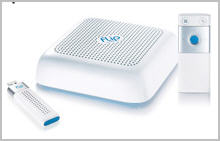-
Flip's New FlipShare TV Will Likely Flop
With today's unveiling of FlipShare TV, the folks behind the enormously popular Flip video cameras are betting that users want to watch their personal videos on their big-screen TVs and also be able to share their videos with friends and family. I think Flip is 100% right about users' interests, but the company's proprietary and expensive FlipShare TV approach is off the mark, and will likely flop. Flip would have had more success by partnering with key players in the video ecosystem, benefiting from both their momentum and numerous co-branding opportunities, while also avoiding costs incurred to develop and market FlipShare TV.
FlipShare TV consists of 3 items: a small base station that connects to the TV via HDMI or composite cables; a USB stick that has a proprietary 801.11n wireless interface so that videos on the computer can be
 streamed to the base station (and hence viewed on the TV); and a remote control. Included FlipShare software lets users create "Flip Channels" which are groups of videos. FlipShare TV costs $150, a not-insignificant amount given Flip video cameras themselves have MSRPs of $150-$230, but can often be found for far less via online deals (I bought my daughter one for $60 recently).
streamed to the base station (and hence viewed on the TV); and a remote control. Included FlipShare software lets users create "Flip Channels" which are groups of videos. FlipShare TV costs $150, a not-insignificant amount given Flip video cameras themselves have MSRPs of $150-$230, but can often be found for far less via online deals (I bought my daughter one for $60 recently).The problem with FlipShare TV is that it takes a grounds-up approach to solving problems that could have been solved instead through smart partnerships and relatively straightforward integrations. Flip should have created a free or nearly free TV viewing and sharing feature that would have helped distinguish Flip's video cameras from the extensive list of competitive products hitting the market rather than creating a whole new product.
FlipShare TV's core proposition is of course making users' videos viewable on their TVs. The most obvious approach to doing so would have been to just partner with convergence product companies who are jockeying for position in the living room. The first partner in this space would have been Roku, which just released open APIs to support its Channel Store. I anticipate many other convergence players (e.g. Blu-ray, Internet TVs, gaming consoles, etc.) will similarly offer APIs to inexpensively broaden their offerings. As this occurs, Flip could have piggybacked on these devices. Netflix is doing this pre-emptively in the absence of APIs through brute force integrations; if it had wanted to, Cisco, Flip's parent, could have afforded to do so as well.
FlipShare TV's other value proposition of sharing could have been addressed through partnerships with companies such as Motionbox, iMemories and Pixorial which are targeting the family's "Chief Memory Officer." Motionbox is in fact already on Roku's Channel Store, which would have meant one less Flip integration. These companies are agnostic about how users capture their video, but all would have likely been eager to partner with well-known Flip to add to their brand awareness and their own value propositions.
YouTube would have been another obvious partner to enhance sharing. Granted YouTube lacks a strategy for getting onto the TV, but its online reach is unparalleled and features that would have enhanced YouTube uploading which is already prevalent among Flip users could have been valuable.
A major kink in FlipShare TV's sharing approach is that the sharee (e.g. grandma and grandpa) themselves also have to buy a FlipShare TV so they have the base station to connect to their TVs. Pew recently estimated 30% of seniors now have broadband Internet access (a number that's likely far higher for grandparents who have tech-forward, Flip-buying kids and grandkids). My guess is that sharing videos via a private YouTube channel would have been adequate for most of them if faced with the alternative of spending $150 for a proprietary setup.
All of these potential opportunities somehow didn't register with the Flip team. Their focus on a proprietary approach seems so complete that they didn't even choose to leverage existing wireless home networks among their target audience (Pew estimates home wireless penetration at about 40% for all broadband homes; it's likely double that or more in homes where a Flip camera's been purchased). Instead, additional cost was added to FlipShare TV system with the proprietary USB wireless stick.
I could be way off base on this and underestimating consumers' willingness to buy proprietary hardware, but I suspect I'm not. FlipShare TV's underlying concept of viewing on TVs and sharing is right on, but my guess is that its execution will yield little success. The lesson here: when partnerships are readily available, capitalize on them.
What do you think? Post a comment now.
Categories: Devices
Topics: Flip, FlipShare TV, iMemories, Motionbox, Pixorial, Roku, YouTube
Posts for 'FlipShare TV'
|


